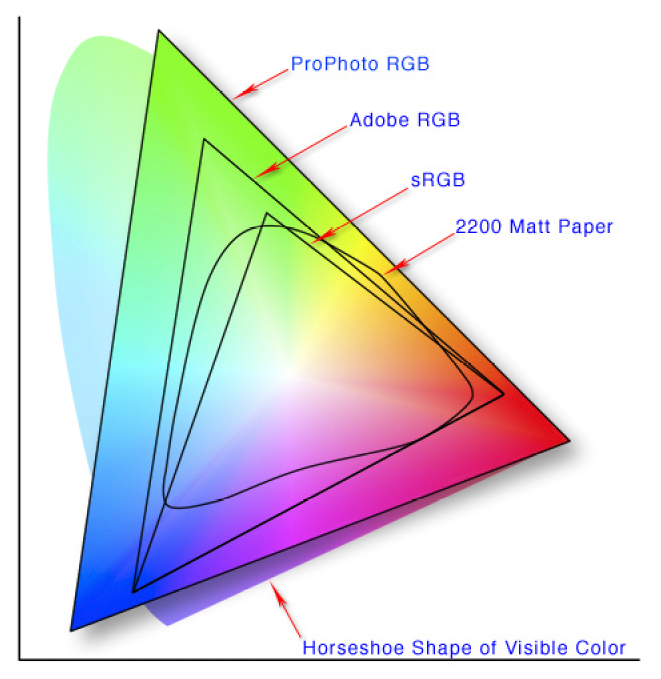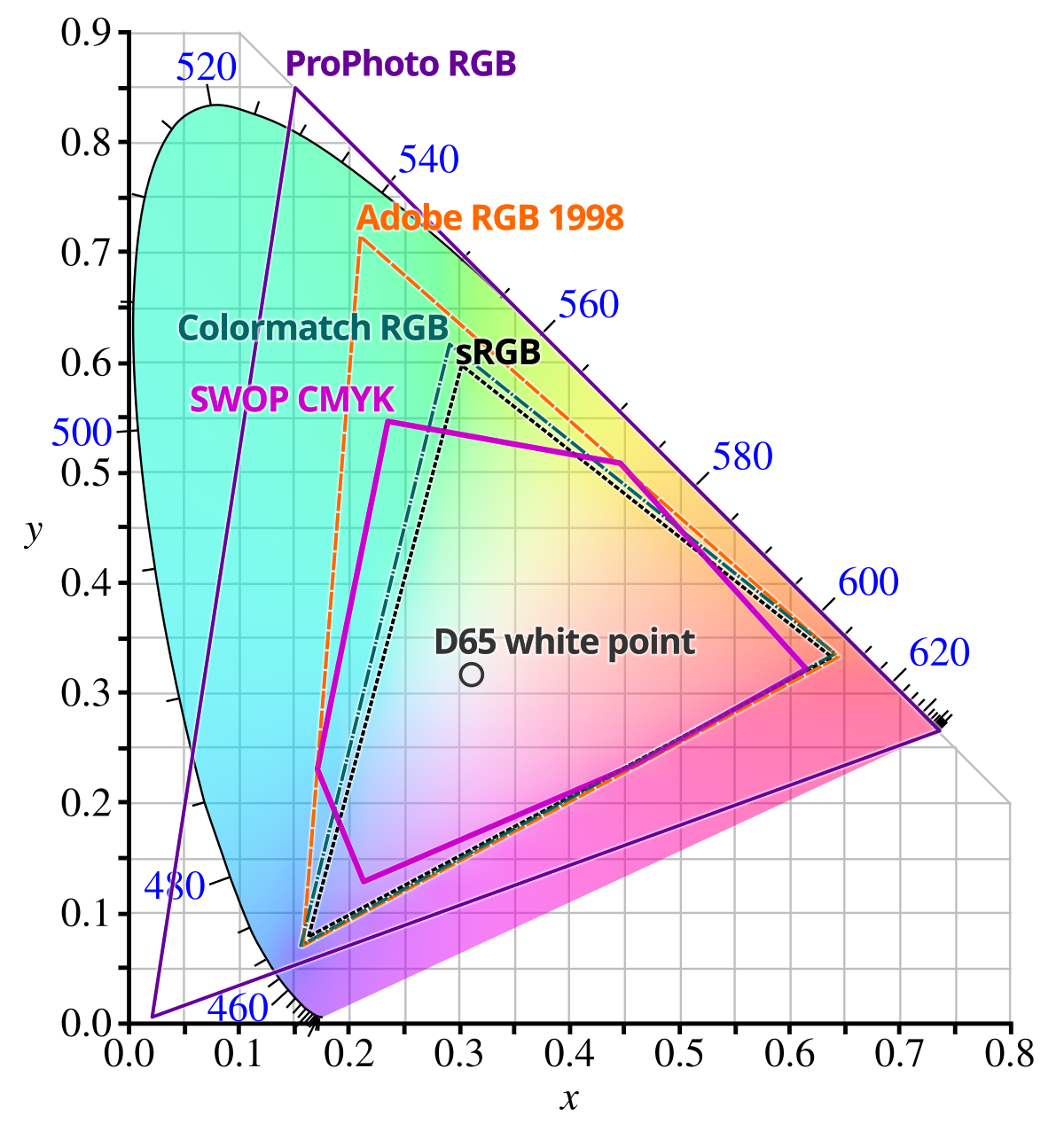The profile would assume the display as only sRGB-capable (so that it would display sRGB and wide gamut content identically), and the calibration data itself would scale down the saturation to match sRGB. This would be pretty much not how icc profiles are supposed to work, but I believe such icc profile could exist in theory.
- Gimp Srgb Color Profile
- Adobe Srgb Color Profile
- Download Srgb Color Profile
- Srgb Color Profile Download
- Srgb Color Profile Missing
Is sRGB the same as RGB?
Basically, it’s a specific range of colors that can be represented. In other words, sRGB can represent the same number of colors as Adobe RGB, but the range of colors that it represents is narrower. Adobe RGB has a wider range of possible colors, but the difference between individual colors is bigger than in sRGB.
- Convert images to the sRGB profile, but don't embed it. Save images in the sRGB profile with gamma 2.2, but don't embed any profile in the image. That's the most compatible and most efficient solution. Software that supports color profiles will assume that images without an embedded profile are in the sRGB profile.
- I understand that C1 changes color display based on monitor profile, so I eventually went to Windows color management and switched my display color profile from 'SRGB,' the default profile, to SRGB IEC 61966-2.1, which is a hidden profile, not the default Surface screen profile.
- An example of Web Browser that doesn't support LUT profiles: Is your monitor able to display wide gamut content? The picture on the left side is low-gamut (sRGB), a picture on the right side is defined in ProPhoto RGB color space. If displayed on wide gamut monitors you can see bright, saturated colors.
- Default Setting: sRGB. Pick up a camera, and more likely than not, the default color space setting is sRGB. These initials stand for standard Red Green Blue, and it dates back to 1996 when HP and Microsoft joined forces to create it. RGB color was the first color space used, and it set the standard for the images we see on screens.
Is RGB a color space?
RGB (Red, Green, Blue) describes the chromacity component of a given color, when excluding luminance. RGB itself is not a color space, it is a color model.
Should I shoot sRGB or Adobe RGB?
Adobe RGB is irrelevant for real photography. sRGB gives better (more consistent) results and the same, or brighter, colors. Using Adobe RGB is one of the leading causes of colors not matching between monitor and print. sRGB is the world’s default color space.
Is 100 Adobe RGB necessary?
no, you don’t need a 100% RGB screen. but you do need some form of calibration hardware. that’s essential.
Does Adobe need RGB monitor?
If your print lab supports Adobe RGB and you edit on a calibrated wide gamut monitor, you should ABSOLUTELY print in Adobe RGB. Wider gamut means your prints will be much more vivid and accurate in color. However, if you don’t print often and/or you’re not using a wide gamut monitor, sRGB is just as amazing.
Is 100% sRGB enough?
sRGB almost always gets 100 percent. However, it the percentage of Adobe RGB coverage that professionals look at for quality monitors. Usually a monitor with a coverage of 97 to 99 percent are considered very good monitors. Some wide gamut monitors fall in this range.
Is a 96 sRGB good?
Given your description you will do just fine with that monitor at 96% sRGB. In fact, in some ways your life is easier as that matches most monitors on the web. Also, though the color gamut is not as large as others, that has the benefit of having less of a need for soft proofing.
Is a 99 sRGB good?
A good monitor for this kind of work needs both a wide colour gamut and an excellent calibration. Here are a few of the terms you will come across: The sRGB colour space is the minimum; Another common standard of colour space is the NTSC gamut – 72% NTSC[1] = 99% sRGB[2].
Is higher sRGB better?
For sRGB native content, 100% is ideal. Anything below that is under-saturated (washed out). Anything above that is over-saturated (overly vibrant). You want 100% sRGB to properly display what the developer/artist intended.
What does 99% sRGB mean?
Standard Red Green Blue
Which is better NTSC or sRGB?
While the range of colors that can be depicted under the NTSC standard is close to that of Adobe RGB, its R and B values differ slightly. The sRGB color gamut covers about 72% of the NTSC gamut. The Adobe RGB color gamut can reproduce more highly saturated colors than sRGB color.
Gimp Srgb Color Profile
Is 45% NTSC good for Photoshop?
A2A. I agree with other answers 45% NTSC for video or photo work is not a good fit. There are many laptops with 60% NTSC or better but you will need to check as different sizes and screen versions could be different even in the same product line.
What is a good NTSC percentage?
Average LCD: 70 to 75 percent of NTSC. Professional non-Wide Gamut LCD: 80 to 90 percent of NTSC. Wide Gamut CCFL LCD: 92 to 100 percent of NTSC.
What is sRGB used for?
The sRGB color space is composed of a specific amount of color information; this data is used to optimize and streamline colors between devices and technical platforms, such as computer screens, printers, and web browsers.
What does 100% sRGB mean?
These refer to the number of colours that a monitor can show in any given colour space. Most decent normal monitors will cover 100% of the sRGB colour space, which translates to about 70% of the Adobe RGB space. If you’re looking to work with Adobe RGB images, you need a monitor that can display 100% of Adobe RGB.
How do I know my sRGB screen?
4 Answers. The tool displaycal-profile-info , part of the DisplayCAL package, can do this. This works (and works basically the same way) for Windows, Mac, and Linux. which has a 60% coverage of sRGB and 43% coverage of Adobe RGB.
Should I use sRGB mode?
Babasaheb purandare books pdf. Normally you would use sRGB mode. Keep in mind that this mode is not calibrated, so your sRGB colors will be different from other sRGB colors. They should be closer. Once in sRGB mode your monitor may not be able to show colors which are outside of sRGB color-space which is why sRGB is not the default mode.
Which monitor mode is best for eyes?
When it comes to color combinations, your eyes prefer black text on a white or slightly yellow background. Other dark-on-light combinations work fine for most people. Avoid low contrast text/background color schemes. If you wear contacts, your eyes have to work harder when staring at a screen.
Is sRGB mode good for eyes?
It’s a restricted colour space, maybe you’re sensitive to some wavelengths outside its gamut. yet I get eye strain unless it’s in sRGB mode, and unfortunately with that monitor if you select sRGB mode you can’t change the brightness for some weird reason so it’s super bright and thus not usable in that mode.
Is sRGB enough for photo editing?
Professional level monitors have expansive color spaces for more vibrant and detailed photos. When you’re shopping around, look out for displays with at least 90% sRGB (best for displaying your work on the web) and 70% Adobe RGB coverage (ideal for printed images).
Is 1080p good enough for photo editing?
For photo editing, aim for at least a Full HD (1920 x 1080) monitor. Even a 4K (3840 x 2160) IPS panel you can get at a reasonable price — but there is basically no upper limit. Size. Bigger is better.

What is the best type of monitor for photo editing?
- BenQ SW2700PT. The best monitor for photo editing, balancing performance and budget.
- BenQ SW321C. The best monitor for photo editing for those with high budgets.
- Asus Designo Curve MX38VC.
- LG 32UN880 UltraFine Ergo.
- Asus ProArt PA329Q.
- Eizo ColorEdge CG319X.
- Dell UltraSharp U2719D.
- Dell UltraSharp UP3216Q.
Is 100 sRGB good for photo editing?
sRGB is the computer standard – that’s going to change in time as it’s not particularly vibrant, but if you have a calibrated 100% sRGB display, it’s the best match for what other people will see on their computers. Even if you have a very poor display you can edit pictures.
Is IPS good for photo editing?
IPS panels are also favored for their innately high-quality color reproduction. In most regards, a monitor with an IPS panel is better for photo-editing than one with a TN panel. An e-IPS panel, for instance, is usually cheaper because it typically runs a lower color depth (i.e. 6-bit) than other IPS types.
Adobe Srgb Color Profile
What laptop do I need for photo editing?
The best laptops for photo editing available now
- MacBook Pro 13-inch (M1, 2020) The best all-round laptop for photo editing.
- Dell XPS 15 (2020)
- Gigabyte Aero 17 (2021)
- MacBook Pro (16-inch, 2019)
- Dell XPS 17 (2020)
- Acer ConceptD 7.
- Apple MacBook Air (M1, 2020)
- Razer Blade 15 Studio Edition (2020)
Does refresh rate matter for photo editing?
While having a high refresh rate is not vital for photo editing it can offer a better all-around experience. It is more important if you plan on using the same monitor for photo editing and gaming, as higher refresh rates will offer smoother gameplay and can also often give lower input lag.
Does your monitor support ICC colour profiles? Green YES - Red NO
Can your monitor display a wide colour gamut? If you see a uniform red square, your monitor cannot display a wide gamut of colours.
If you see the W letter inside the square, your monitor is wide gamut.
How far from sRGB is your display color gamut? The more difference you see inside the squares, the further your display color gamut is from sRGB standard.
ProPhoto tagged image
sRGB tagged image
How does your browser interpret untagged images? All untagged images and page elements should be considered sRGB by the web browser, according to The World Wide Web Consortium (W3C). If your browser respects this standard, you should see perfectly uniform colour squares above.
Melco design shop pro plus free download. sRGB untagged
sRGB tagged image

How does your browser interpret page elements? All untagged images and page elements should be considered sRGB by the web browser, according to The World Wide Web Consortium (W3C). If your browser respects this standard, you should see perfectly uniform colour squares above.
Untagged CSS element
sRGB image
Download Srgb Color Profile

Srgb Color Profile Download
sRGB vs DCI-P3 Display vs Rec2020
Srgb Color Profile Missing
- sRGB
- DCI-P3 Display
- Rec2020